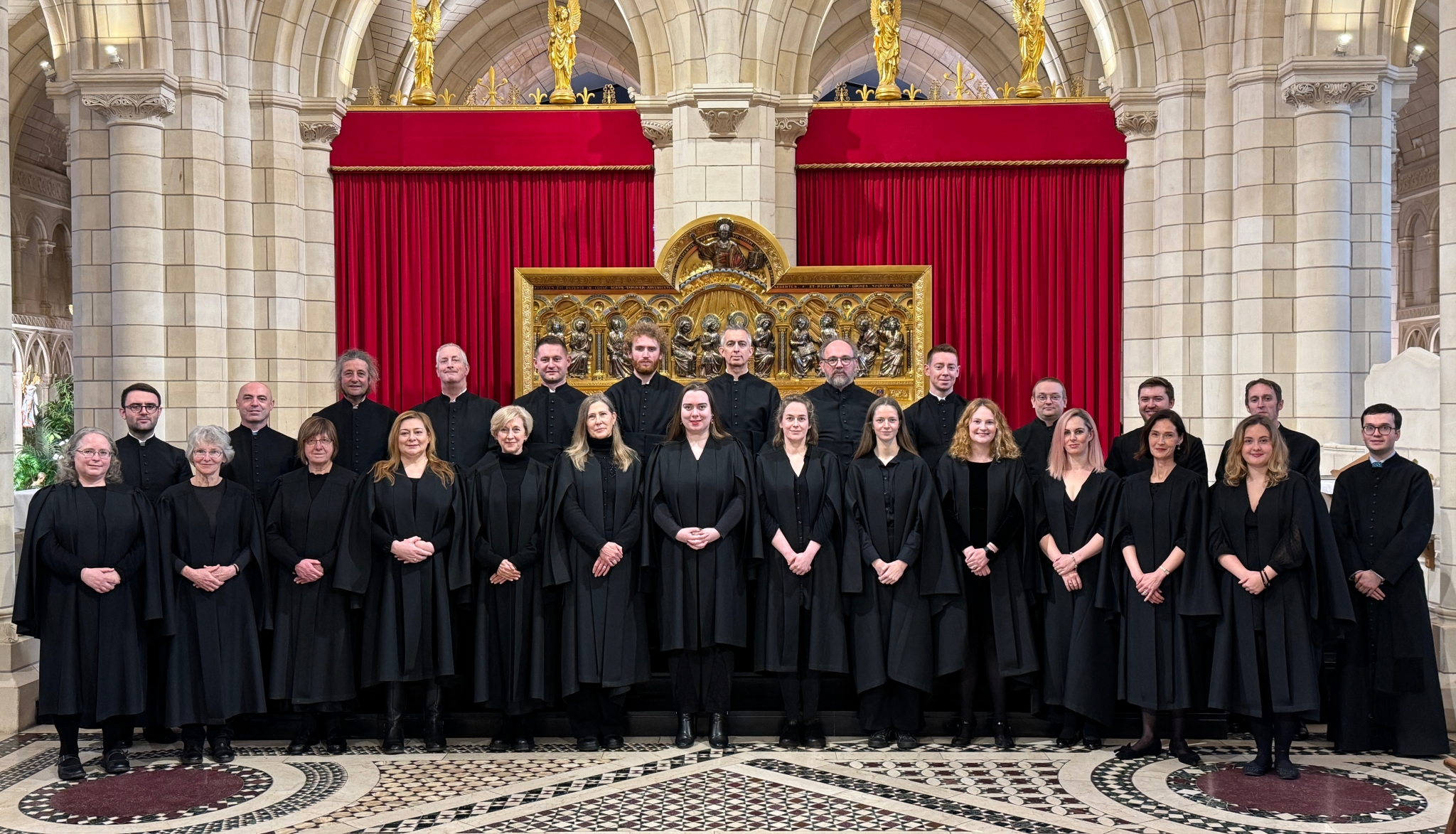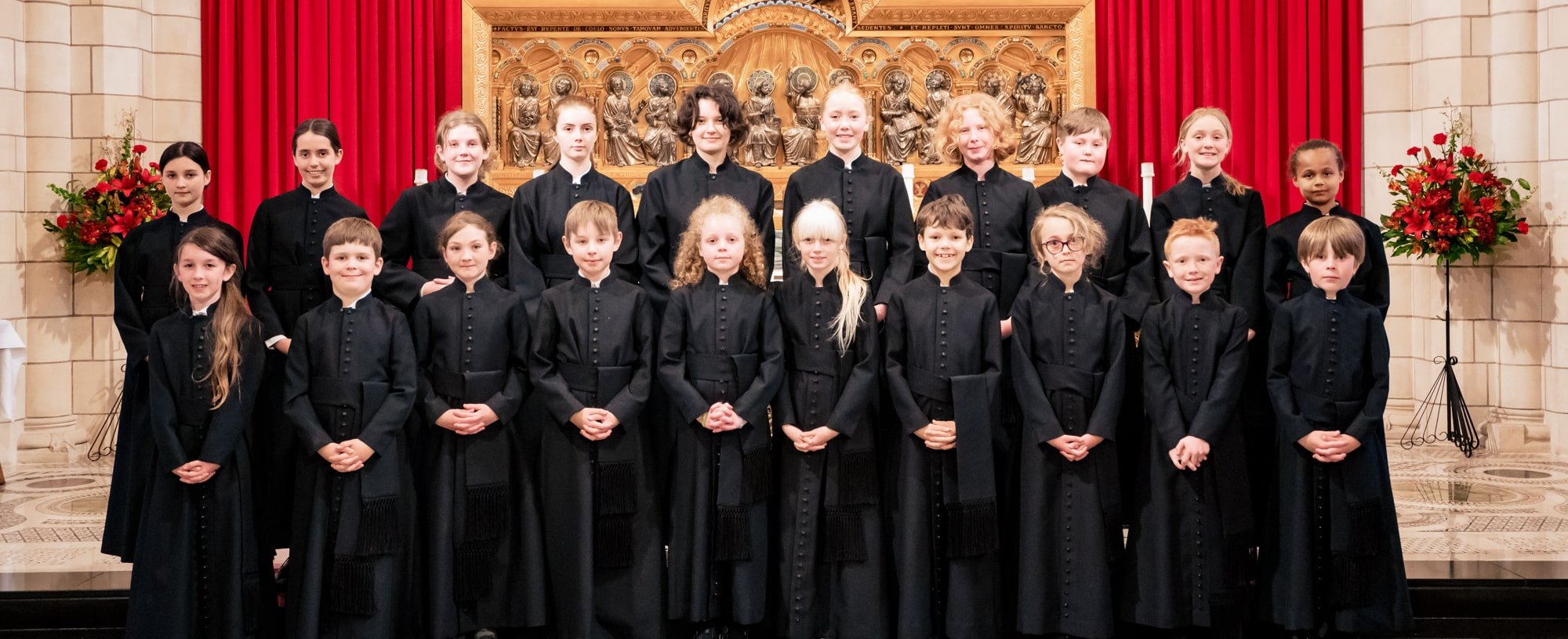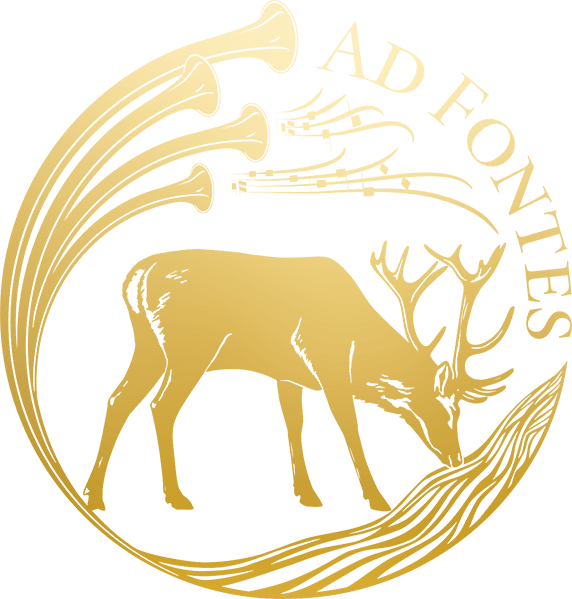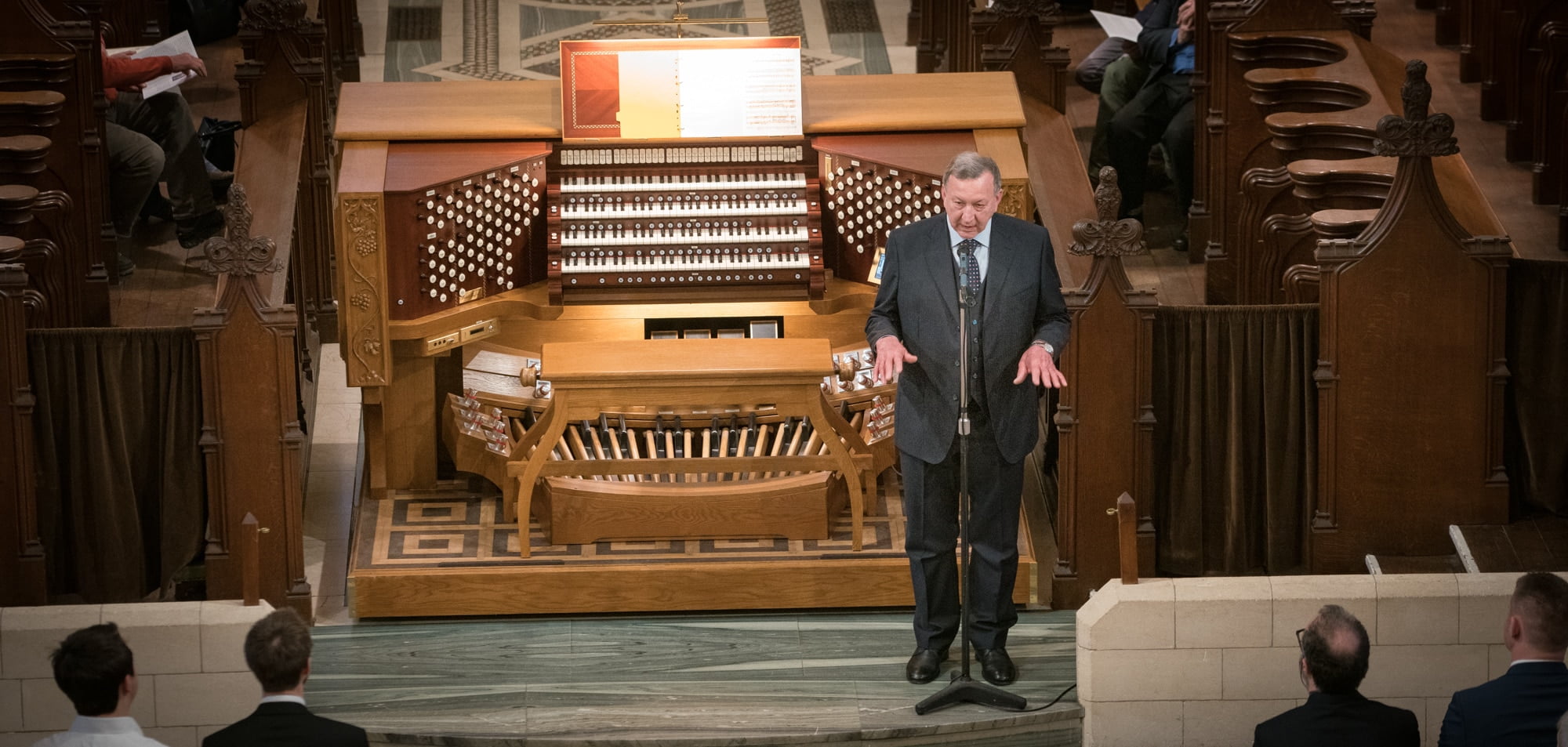Music at Buckfast Abbey
‘I will sing and make music for the Lord’. (Psalm 26)
Music plays a fundamental role in the life of the Abbey, whether it be Gregorian Chant sung by the Monastic Community at the Daily Office, or choral music sung by the Abbey Choir at Solemn Mass & Vespers. The Abbey is a vibrant centre of musical activity in Devon that hosts a popular series of concerts and organ recitals.
Subscribe to our newsletter to be the first to hear about forthcoming concerts, recitals and recordings.
Sign up with your email address to receive news and updates.
Matthew Searles — Master of the Music
Matthew Searles is Master of the Music at Buckfast Abbey. He is responsible for all aspects of the musical life of the Abbey, including the daily Mass and Office, direction of the Abbey Choir, and is Executive Producer of the in-house record Label, Ad Fontes. Matthew joined the Abbey in 2018 as Assistant Master of the Music, during which time he helped to re-establish a treble line of choristers, and played for Midnight Mass, televised live on BBC One. Prior to moving to Buckfast, Matthew was Sub-Organist of Liverpool Metropolitan Cathedral. He is a prizewinning graduate of Royal Holloway, University of London, where he received First Class Honours and the Driver Prize for ‘outstanding musical performance’. Matthew continued his studies at the Conservatoire à Rayonnement Régional de Poitiers, France. He is a Fellow of the Royal College of Organists.
Robert Pecksmith — Assistant Master of the Music
Robert Pecksmith is Assistant Master of the Music at Buckfast Abbey, where he is responsible for the training of the Abbey choristers and shares in the organ playing for the daily Office and at the daily Mass in the Abbey. Previously, Robert held appointments at St James’ Cathedral in Toronto, Wakefield Cathedral, and the York Oratory, where he was Assistant Director of Music between 2015 and 2020. Robert trained as an organist at the junior department of the Royal Birmingham Conservatoire and later as organ scholar at Somerville College, Oxford, where he read history. He is a Fellow of the Royal College of Organists.
Charles Maxtone-Smith — Organist
Charles Maxtone-Smith is Organist of Buckfast Abbey. He graduated from the Royal Academy of Music in 2023 with the Advanced Diploma, MA Distinction and the DipRAM award, as a student of David Titterington, Bine Bryndorf, and Richard Pinel. He won the Musicians’ Company Award for Organists in 2023, which provides generous funding for two years of further study. He currently takes lessons with Christophe Mantoux at Saint-Séverin, Paris, studying French Baroque and Romantic literature. He successively held organ scholarships at Hereford Cathedral, New College, Oxford, Westminster Abbey, Royal Hospital Chelsea, and King’s College, London. Since 2014 he has been one of the Festival Organists at the annual Edington Festival of Music within the Liturgy, and has played for several BBC Radio 3 broadcasts.

The present incarnation Abbey Choir was founded in 2009 and has since established a broad liturgical repertoire, embracing polyphony of the sixteenth century and great Viennese Masses, music of the French Romantic tradition and contemporary works by James MacMillan, Matthew Martin and Dom Sebastian Wolff OSB. In recent years the choir has commissioned a set of eight fauxbourdon Magnificats from Andrew Reid, and given the premiere of a new Mass by Martin Baker.
At the heart of its work, the choir sings Solemn Mass and Vespers each Sunday, together with Mass on Holy Days of Obligation during the week. A smaller schola supports the singing of the Monastic Community during choir holidays. Alongside its liturgical commitments, the Abbey Choir gives regular concert performances, with highlights including Charpentier’s Messe de minuit with Noxwode Baroque and the Duruflé Requiem with the Southern Sinfonia.
Since releasing its first commercial recording in 2014, the choir has developed an emerging discography on the Abbey’s in-house label, Ad Fontes. Its most recent album—a sequence of music for Corpus Christi—was described as “a taste of heaven” in a five-star review by Choir & Organ. In 2018, at the conclusion of Buckfast’s millennium year, the Abbey Choir sang Midnight Mass, which was televised live on BBC One, and a service of Vespers for Pentecost was recently broadcast by BBC Radio 3.

In 2018 Buckfast Abbey celebrated 1000 years since its foundation. As a lasting legacy, the Abbey founded a choir of choristers offering the opportunity for boys and girls aged between 7 and 14 to enhance the glorious surroundings of the Abbey through their singing at regular Masses, as well as to perform in concerts and an annual tour. Each chorister receives a scholarship from the Abbey for individual vocal and piano tuition, and works towards exams in singing and piano for the Associated Board of the Royal School of Music.
Becoming an Abbey Chorister is a unique, life-changing, opportunity for children who are interested in participating in a professional choir. Choristers are recruited from schools in the local area, both state and independent.
If your child loves to sing and is interested in this opportunity, just send an email to music@buckfast.org.uk
The Abbey is a vibrant centre of musical activity in Devon that hosts a diverse and popular series of concerts and organ recitals. Several world-class musicians have performed here, and the annual schedule of musical events also creates opportunities for local groups to enjoy making music in the Abbey Church, alongside concerts given by our own musicians.
Our Concerts & Organ Recitals 2026 brochure is available to download here.
Forthcoming concerts:
For a full list of concerts, click here.

Ad Fontes is a record label founded by Buckfast Abbey dedicated to presenting recordings of the finest sacred music. Given its roots within the Roman Catholic Benedictine tradition, the label specialises in choral and organ music drawn from that rich heritage, with a focus on the Choir of Buckfast Abbey and the new Ruffatti organ. The name of the label is taken from the Abbey’s motto, Psalm 41: Sicut cervus desiderat ad fontes aquarum ita desiderat anima mea ad te, Deus (Like the deer that yearns for running streams, so my soul is yearning for you, my God). For more information, visit www.adfontes.org.uk

Buckfast Abbey is delighted to have the first organ in the United Kingdom by the renowned Italian organ builder, Fratelli Ruffatti. The instrument consists of a substantial Quire Organ (four divisions and pedal) located on both sides of the Quire and the upper triforium, and a Grand-Orgue in the West Gallery (two divisions and pedal). The scale of the instruments allows a rich variety of tonal colour which encourages creativity in the accompaniment of the Monastic Community and Abbey Choir, as well as providing the versatility necessary for a wide range of organ repertoire. An exciting feature of the two spatially-separated instruments is the possibility of playing antiphonally, as well as the ability to play the instruments together (from one, or both, consoles).
A notable feature of the Quire Organ is an Italian-inspired Positivo division, which includes a number of special effects including a Nightingale, Zimblestern, Glockenspiel, Drum and Bagpipes; features common in Italian organs of the Renaissance and unique tools in improvisation and organ repertoire of the period.
The organ features two high-pressure reed stops: a bright Pontifical Trumpet en chamade, protruding horizontally from the West Gallery casework, and a darker, more tuba-like Abbatial Trumpet, located in the triforium.



The tonal character of the Grand-Orgue in the West Gallery is inspired by the French romantic tradition, and the scalings and manufacturing practices of Aristide Cavaillé-Coll. The pipes feature the characteristic arched and protruding upper and lower lips. The instrument is contained in two cases and designed to be in harmony with the surrounding architecture, so as not to obscure the stained glass. Since the organ sings directly on the longitudinal axis of the building, it supports congregational singing well, and whilst the instrument can be used independently, its tonal qualities integrate well with the Quire Organ, forming one homogeneous, cohesive instrument.
Two, four-manual consoles control the instruments: one located in the West Gallery and a moveable console, with electronic height adjustment, located in the Quire.
The instrument is used daily to accompany the Monastic Services, and features regularly in our concert series.
POSITIVO Unenclosed Manual I
| Principale | 8’ | |
| Bordone | 8’ | |
| Voce Umana | 8’ | |
| Ottava | 4’ | |
| Flauto Veneziano | 4’ | |
| Decimaquinta | 2’ | |
| Decimanona | 1 1/3’ | |
| Sesquialtera II | 2 2/3’-1 3/5’ | |
| Ripieno III (26-29-33) | 2/3’ | |
| Cromorno | 8’ | |
| Pontifical Trumpet | 8’ | Solo (unenclosed) |
| Abbatial Trumpet | 8’ | Solo (unenclosed) |
| Tremulant | ||
| Glockenspiel | 30 bells | |
| Nightingale | 5 pipes immersed | |
| Cymbelstern | 12 bells | |
| Drum | ||
| Bagpipe C | 4’ | |
| Bagpipe F | 3’ | |
| Bagpipe G | 2 2/3 |
SWELL Enclosed Manual III
| Flute à Cheminée | 8’ | |
| Gemshorn | 8’ | |
| Viole de Gambe | 8’ | |
| Voix Céleste | 8’ | |
| Prestant | 4’ | |
| Flûte Creuse | 4’ | |
| Nazard | 2 2/3’ | |
| Octavin | 2’ | |
| Tierce | 1 3/5’ | |
| Plein Jeu IV (15-19-22-26) | 2’ | |
| Basson | 16’ | |
| Trompette Harmonique | 8’ | |
| Hautbois | 8’ | |
| Clairon Harmonique | 4’ | |
| Tremulant | ||
| Sub Octave | ||
| Unison Off | ||
| Super Octave |
PEDAL Unenclosed
| Contra Bourdon | 32’ | |
| Contrabass | 16’ | |
| Subbass | 16’ | |
| Bourdon | 16’ | |
| Lieblich Bourdon | 16’ | |
| Quintf | 10 2/3’ | |
| Octave | 8’ | |
| Flûte Ouverte | 8’ | |
| Nazard | 5 1/3’ | |
| Superoctave | 4’ | |
| Flute | 2’ | |
| Mixture IV (12-15-19-22) | 2 2/3’ | |
| Fagott | 32’ | |
| Bombarde | 16’ | |
| Basson | 16’ | Swell |
| Trompette | 8’ | |
| Schalmei | 4’ |
GREAT Unenclosed Manual II
| Bourdon | 16’ | |
| Principal | 8’ | |
| Bourdon | 8’ | |
| Spitzflöte | 8’ | |
| Octave | 4’ | |
| Blockflöte | 4’ | |
| Quint | 2 2/3’ | |
| Superoctave | 2’ | |
| Mixture IV (19-22-26-29) | 1 1/3’ | |
| Terz Zimbel III (29-31-33) | 1/2’ | |
| Trumpet | 8’ | |
| Clairon | 4’ | |
| Pontifical Trumpet | 8’ | Solo (unenclosed) |
| Abbatial Trumpet | 8’ | Solo (unenclosed) |
| Sub Octave | ||
| Unison Off |
SOLO Enclosed Manual IV
| Lieblich Bourdon | 16’ | |
| Orchestral Flute | 8’ | |
| Doppelflöte | 8’ | |
| Salicional | 8’ | |
| Unda Maris | 8’ | |
| Flûte Douce | 8’ | |
| Flûte Celeste | 8’ | |
| Flauto d’Amore | 4’ | |
| Harmonic Nazard | 2 2/3’ | |
| Harmonic Piccolo | 2’ | |
| Harmonic Tierce | 1 3/5’ | |
| Bassett Horn | 8’ | |
| Vox Humana | 8’ | |
| Pontifical Trumpet | 8’ | Unenclosed |
| Abbatial Trumpet | 8’ | Unenclosed |
| Tremulant | ||
| Sub Octave | ||
| Unison Off | ||
| Super Octave |
GRAND-ORGUE Unenclosed
| Bourdon | 16’ | |
| Montre | 8’ | |
| Flûte Harmonique | 8’ | |
| Bourdon | 8’ | |
| Prestant | 4’ | |
| Flûte Octaviante | 4’ | |
| Cornet III | 2 2/3-2’-1 3/5’ | |
| Doublette | 2’ | |
| Plein Jeu III-V (15-19-22) | 2’ | |
| Clarinette | 8’ | |
| Pontifical Trumpet | 8’ | Solo |
Abbatial Trumpet | 8’ | Solo |
| Tremblant | ||
| Sub Octave | ||
| Unison Off |
PÉDALE Unenclosed
| Soubasse | 16’ |
| Bourdon | 16’ |
| Basse | 8’ |
| Bourdon | 8’ |
| Flûte | 4’ |
| Bombarde | 32’ |
| Bombarde | 16’ |
| Trompette | 8’ |
EXPRESSIF Enclosed
| Violoncelle | 8’ |
| Violoncelle Céleste | 8’ |
| Cor de Chamois | 8’ |
| Cor de Chamois Céleste | 8’ |
| Prestant | 4’ |
| Trompette | 8’ |
| Clairon | 4’ |
| Tremblant | |
| Sub Octave | |
| Unison Off | |
| Super Octave |
STATISTICS Quire Organ and Gallery organ combined
78 real stops |
100 ranks of pipes |
5,537 pipes |
42 bells |
